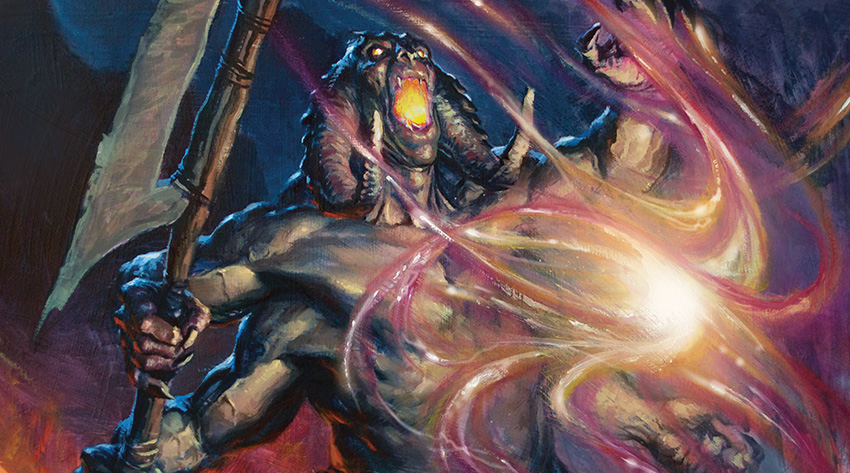Epic Preparations
Good Morning, EDHREC! I’m Bernardo Melibeu and this is The Epic Experiment, a series where we throw all common sense aside and experiment with some unusual cards, effectively changing how we normally build our deck. Is it going to work? Who knows?! We’re making science here. When you’re an Izzet mage, blowing things up in front of your own face is half the fun.
In this article we're going to look at the big Glint-Eye himself: Yidris, Maelstrom WielderYidris, Maelstrom Wielder.
Let's take a look at his abilities and see what can we come up with.

Trample
When Yidris, Maelstrom Wielder deals combat damage to a player, as you cast spells from your hand this turn, they gain cascade.
Observation 1:
His kit is very combat-oriented and rewards you for being aggressive.
Observation 2:
Giving him double strike means double Cascade.
Observation 3:
With 5 power and trample-y evasion, it's very easy to threaten death by commander damage.
Observation 4:
The Cascade effect gives him crazy amount of card advantage.
Observation 5:
His kit, in a way, constrains our deck building. Reactive spells, like counterspells and removal, have to be able to do something if Cascaded into.
The Old Formula
With that in mind, let's go to Yidris' EDHREC page and see how folks usually build him:
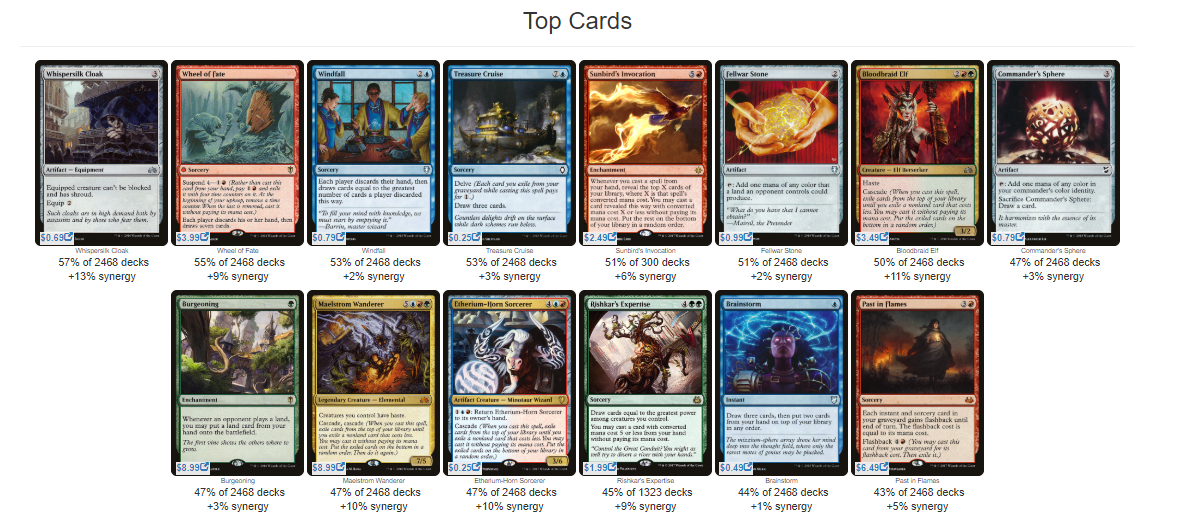
Yidris doesn't have Signature Cards! What does that mean? It's simple: there aren't any cards that are exclusively played by him. Meaning that most of his deck consists of goodstuff.
As for the Top Cards section, we can see that people are trying to abuse the cascade mechanic by playing more cards with Cascade and card draw.
The Epic Ingredients
I have a soft spot for Voltron strategies, and when a commander actively rewards you for hitting people... well, I just can't help myself. I chose to focus on Auras because they synergize with Cascade, as opposed to Equipment, which you'll still need to pay equip costs for. Giving Cascade to all spells in hand provide us the unique opportunity of passively growing our commander with Auras. And since we're playing a deck full of them, it means that most of our Cascades will hit one, so, in the end, each Aura we play has another attached to it.

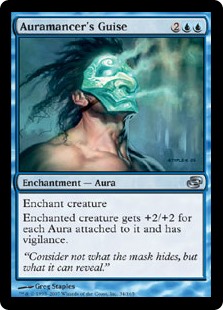

When playing Voltron, there are three factors that we must focus on to have a good time: power, evasion, and protection. Yidris already has two out of those; his 5 power is pretty easy to boost up to get to the 3-hit mark (7 power across three hits = 21 lethal commander damage), and because of the sheer amount of Auras we'll get on him it's not hard to get to the 2-hit mark (11 power). He also has trample, which is a big help. Our Aura suite is very flexible and most of them pull double duty (or quadruple duty, since they'll Cascade into another Aura! #Math). Turns out having 4 colors worth of Auras give us really powerful choices.
Giving Yidris double strike is very important, since he'll grant double Cascade. We have a few double strike enablers, such as Runes of the DeusRunes of the Deus, which also puts Yidris into the 2-hits club, and FireshriekerFireshrieker, which has the benefit of remaining on the field in case Yidris ever get removed. We're also packing a couple of extra combat spells, which easily could have been extra turn spells if we so desired, and which more or less have the same effect as granting double strike for a turn, with the benefit of stacking with the Cascade keyword.

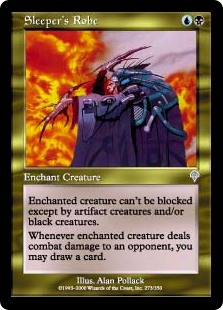
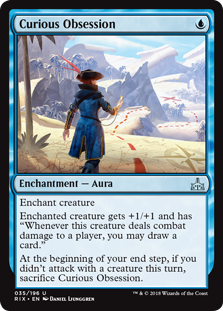
Since we need to amass a critical number of Auras, our card draw is focused on CuriosityCuriosity effects. They also have the additional benefit of synergizing with our double strike enablers. Helm of the GhastlordHelm of the Ghastlord pumps Yidris, Sleeper's RobeSleeper's Robe gives evasion, and finally Snake UmbraSnake Umbra gives us some much-needed protection.
The Mixture
Yidris Voltron
View on ArchidektCommander (1)
- 1 * Yidris, Maelstrom Wielder* Yidris, Maelstrom Wielder
Enchantment (38)
- 1 * Instill Energy* Instill Energy
- 1 * Keen Sense* Keen Sense
- 1 * Sixth Sense* Sixth Sense
- 1 * Rancor* Rancor
- 1 * Spider Umbra* Spider Umbra
- 1 * Aqueous Form* Aqueous Form
- 1 * Curiosity* Curiosity
- 1 * Curious Obsession* Curious Obsession
- 1 * Shimmering Wings* Shimmering Wings
- 1 * Cartouche of Zeal* Cartouche of Zeal
- 1 * Hammerhand* Hammerhand
- 1 * Molting Snakeskin* Molting Snakeskin
- 1 * Favor of the Overbeing* Favor of the Overbeing
- 1 * Magefire Wings* Magefire Wings
- 1 * Sleeper's Robe* Sleeper's Robe
- 1 * Alpha Authority* Alpha Authority
- 1 * Canopy Cover* Canopy Cover
- 1 * Cartouche of Knowledge* Cartouche of Knowledge
- 1 * Ghostly Wings* Ghostly Wings
- 1 * Phantom Wings* Phantom Wings
- 1 * Spectral Flight* Spectral Flight
- 1 * Giant Spectacle* Giant Spectacle
- 1 * Goblin War Paint* Goblin War Paint
- 1 * Madcap Skills* Madcap Skills
- 1 * Swashbuckling* Swashbuckling
- 1 * Shielding Plax* Shielding Plax
- 1 * Ancestral Mask* Ancestral Mask
- 1 * Boar Umbra* Boar Umbra
- 1 * Snake Umbra* Snake Umbra
- 1 * Grisly Transformation* Grisly Transformation
- 1 * Untamed Hunger* Untamed Hunger
- 1 * Helm of the Ghastlord* Helm of the Ghastlord
- 1 * Tricks of the Trade* Tricks of the Trade
- 1 * Blood mist* Blood mist
- 1 * Bear Umbra* Bear Umbra
- 1 * Auramancer's Guise* Auramancer's Guise
- 1 * Runes of the Deus* Runes of the Deus
- 1 * Berserkers' Onslaught* Berserkers' Onslaught
Artifact (10)
- 1 * Sol Ring* Sol Ring
- 1 * Dimir Signet* Dimir Signet
- 1 * Golgari Signet* Golgari Signet
- 1 * Gruul Signet* Gruul Signet
- 1 * Izzet Signet* Izzet Signet
- 1 * Rakdos Signet* Rakdos Signet
- 1 * Simic Signet* Simic Signet
- 1 * Fellwar Stone* Fellwar Stone
- 1 * Swiftfoot Boots* Swiftfoot Boots
- 1 * Fireshrieker* Fireshrieker
Sorcery (10)
- 1 * Ancestral Vision* Ancestral Vision
- 1 * Farseek* Farseek
- 1 * Nature's Lore* Nature's Lore
- 1 * Rampant Growth* Rampant Growth
- 1 * Decimate* Decimate
- 1 * Harmonize* Harmonize
- 1 * Relentless Assault* Relentless Assault
- 1 * Creeping Renaissance* Creeping Renaissance
- 1 * World at War* World at War
- 1 * Rishkar's Expertise* Rishkar's Expertise
Instant (5)
- 1 * Nature's Claim* Nature's Claim
- 1 * Cyclonic Rift* Cyclonic Rift
- 1 * Beast Within* Beast Within
- 1 * Putrefy* Putrefy
- 1 * Windgrace's Judgment* Windgrace's Judgment
Land (36)
- 1 * Command Tower* Command Tower
- 1 * City of Brass* City of Brass
- 1 * Mana Confluence* Mana Confluence
- 1 * Exotic Orchard* Exotic Orchard
- 1 * Bloodstained Mire* Bloodstained Mire
- 1 * Flooded Strand* Flooded Strand
- 1 * Polluted Delta* Polluted Delta
- 1 * Windswept Heath* Windswept Heath
- 1 * Wooded Foothills* Wooded Foothills
- 1 * Blood Crypt* Blood Crypt
- 1 * Breeding Pool* Breeding Pool
- 1 * Overgrown Tomb* Overgrown Tomb
- 1 * Steam Vents* Steam Vents
- 1 * Stomping Ground* Stomping Ground
- 1 * Watery Grave* Watery Grave
- 1 * Cinder Glade* Cinder Glade
- 1 * Smoldering Marsh* Smoldering Marsh
- 1 * Sunken Hollow* Sunken Hollow
- 1 * Karplusan Forest* Karplusan Forest
- 1 * Llanowar Wastes* Llanowar Wastes
- 1 * Shivan Reef* Shivan Reef
- 1 * Sulfurous Spring* Sulfurous Spring
- 1 * Underground River* Underground River
- 1 * Yavimaya Coast* Yavimaya Coast
- 1 * Blooming Marsh* Blooming Marsh
- 1 * Botanical Sanctum* Botanical Sanctum
- 1 * Spirebluff Canal* Spirebluff Canal
- 4 ForestForest
- 2 IslandIsland
- 2 MountainMountain
- 1 * Swamp* Swamp
One thing to note about this list (and Yidris in general) is that it can't afford to be defensive. Cascading into a reactive spell, like CounterspellCounterspell, is just bad and so is Cascading into a dead removal spell. Because of that, our removal suite has a wide range of targets. Windgrace's JudgmentWindgrace's Judgment is a good example of this, as it'll never be blank.
The mana base is on a more expensive side of the force, with fetches and dual lands. Although they aren't required, the goal is to hit early with Yidris, so it's important to craft a manabase that allows you to consistently cast Yidris asap, preferably by turn 3. Our ramp suite was also built with that in mind.
Methodology
Our plan is very simple: find one unlucky opponent and hit them to death with Yidris!
All jokes aside, there are some nuances to this deck that we need to master to play it at its fullest. The first one is a problem common to Voltron decks: choosing the right target. Too often, Voltron decks 'gas out' after eliminating a player, or they spread their damage across the table and end up short, which leads to games where a player has to sit out and watch while the rest of the table durdle around.
Our ideal hand contains a couple of Auras, some lands, and a 2-drop ramp (Signets or ramp spell). It's very important to try to achieve the turn 3 Yidris. For this we have to get to 4 mana on turn 3, and in the right colors, so it's important to fetch carefully. After Yidris successfully survives the first turn cycle on the battlefield, we get to the second issue of the deck. We need to decide between casting spells before attacking, and thus making Yidris stronger, or waiting after he connects to get the Cascade going.
For that situation, we need to ask ourselves, "Can we successfully hit a player with Yidris?" If yes, then we should wait. Elsewise, "Do we have something in our hand that allows us to successfully hit a player with Yidris?" If yes, we should cast it before combat. There're others timing scenarios that we'll frequently run into, such the casting of 1-drops (which will depend on whether we've already hit Ancestral VisionAncestral Vision, our only 0-drop). As a general case, I'll always try to abuse the Cascade. It's true that we have to wait a full turn cycle to reap the benefits, but we also presents an overall faster clock and don't risk over-committing to the board. But I can see how a middle ground approach could be reasonable.
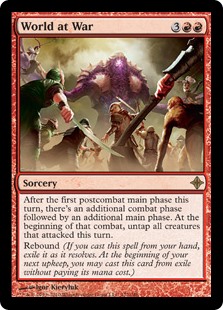

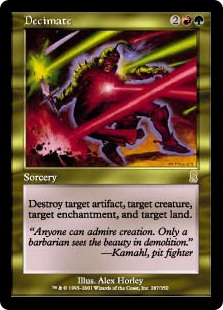
By the mid game we should have eliminated one opponent or at least be close to doing so. We have some protection on our commander, he's hitting for at least 8-9, and we're getting full value of our Cascades. In other words, life is good. It's now when the veteran player recognizes the third hurdle with the deck: knowing when to stop playing Auras. Do we really need to cast that Goblin War PaintGoblin War Paint at this point? As an Aura-based deck, we don't have the same luxury that Equipment-based decks have, to leave their cards on the battlefield if the Voltron dies. Holding Auras in our hand means that if we ever lose Yidris, we'll be able to quickly recover, especially with if any of those Auras grant haste.
By the late game we'll either be a unstoppable force or we'll at least represent a hasty threat. Cards are not a problem, because each spell we cast potentially has another one stapled to it. This is where we see the importance of eliminating players earlier in the game; the less players there are, the less removal for Yidris, and the easier it becomes to end the game.
Epic Results
Building a 4-colored general means that we'll always have choices, from removal to the Auras. As I said before, we could've added extra turns spells to the list and traded the extra combat spells for them. The reason I didn't was just to lower the overall curve of the deck, making it run (harder, better,) faster (stronger).
One card that didn't quite make the cut was Baral's ExpertiseBaral's Expertise. It's a good card on the list and it synergizes well with Cascade (both the Expertise and the free spell it casts will flip into additional spells), but the double blue requirement and the impermanence of its ability are huge costs that I didn't think were ultimately worthwhile. If this list had the extra turn spells, it would possibly be an auto-include.
As for Auras, I'm pretty satisfied with the ones we have, but this is pretty much meta-dependent. If your meta runs many board wipes/removal, add more defensive/haste-granting Auras, If your meta plays combos, you should add power-buffing Auras, to defeat them with fewer hits.
When changing the mana base for a more budget-friendly one, I would suggest adding the Talisman cycle (such as Talisman of DominanceTalisman of Dominance) in place of the ramp spells, running Checklands (like Dragonskull SummitDragonskull Summit and more basic lands. The cost of not being able to cast Yidris on turn 3/4 is pretty huge, so tapped lands can really mess up an opening.
That’s it for this Epic Experiment! Please fell free to leave any suggestions in the comments section. Do you have any questions about the list? Which cards did you like? Which didn’t you? Was the Epic Experiment a success? Please let me know!
Bernardo Melibeu
Bernardo has been playing(on and off) since portal and somehow manage to survive mirrodin block while being a total casual(beast tribal ftw?). He loves all the shades of blue and being the one saying "nope", while holding a full grip of cards in hand.
Your opinions are welcome. We love hearing what you think about Magic! We ask that you are always respectful when commenting. Please keep in mind how your comments could be interpreted by others. Personal attacks on our writers or other commenters will not be tolerated. Your comments may be removed if your language could be interpreted as aggressive or disrespectful. You may also be banned from writing further comments.
